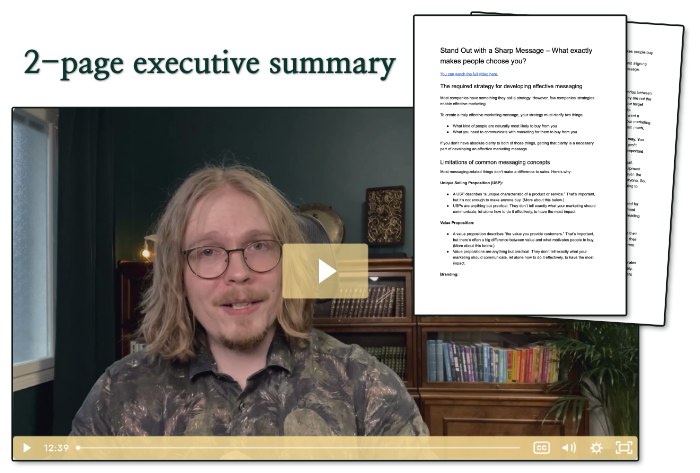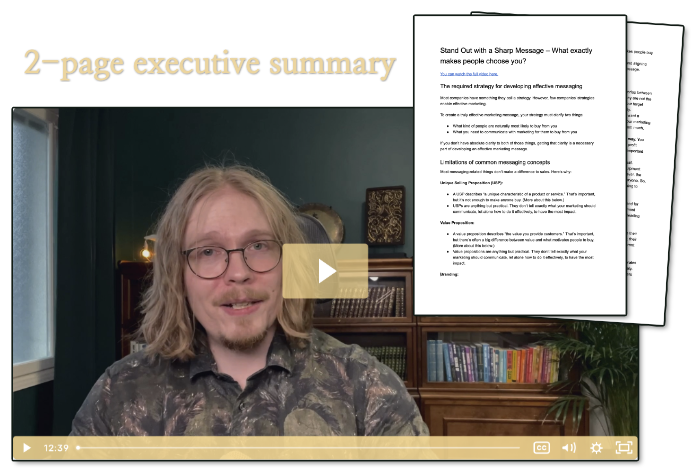Email marketing strategies have plenty of variation. There are the ones based on autoresponders (if you build a good autoresponder sales funnel, you can get amazing results). There’s the “send as often as you can” email marketing strategy, which only works in specific situations. And there are countless others, too.
Marketing people keep saying, “You can get amazing results with email marketing.”
But most people don’t get the promised results. Instead, your subscribers demand more free content, reply with critical comments when you make a grammar mistake, and unsubscribe in hoards the moment they see a link to a sales page.
Don’t blame the marketing tactic—learn to use it.
If you can’t use the different strategies, you can’t expect good results. And if you don’t use all of them, your results won’t be impressive.
Typically you should use all three email marketing strategies. You can emphasize some more than others, but you shouldn’t stubbornly stick to one strategy.
They all aim to generate sales. But they go at it in different ways. They have different advantages and disadvantages.
If you use them all the right way, your email marketing can be more effective than any other marketing you do.
What makes email marketing strategies so effective?
Email marketing has some significant advantages compared to most other marketing methods:
- High reach: When people join your email list (subscribe or “opt in”), you can reach them. If they just like your Facebook page, for example, it’s unlikely that they’d see many of your updates. Sure, not everyone opens your emails, but the numbers are heavily in favor of email marketing compared to other similar marketing tactics. I’d rather get 1,000 new email subscribers than 10,000 Twitter followers.
- Great flexibility: Email marketing can work for every business. It doesn’t matter whether you sell houses, lingerie, or consulting; you can get lots of sales if you use the right email marketing strategy in the right place. And you can promote practically anything relating to your business—you aren’t limited to sending links to your sales pages. Or rather, if your emails are just links to sales pages, you’re doing it wrong.
- Minimal risk: Some top marketers expect to burn through $10,000 of advertising budget before even knowing if they can make a campaign profitable. (Nope, that’s not an exaggeration. But I’d usually aim for a few hundred dollars—not thousands.) With email marketing, the costs are much, much lower. A simple email marketing software like AWeber is very affordable even if your business isn’t a huge success, yet. And even if you go with something advanced like Infusionsoft, you’re still far away from the kinds of investments many other marketing tactics require. Sure, email marketing and advertising aren’t directly comparable (advertising is mainly used to reach new prospects). But you get the point.
- Low barrier of entry: Email marketing is comparatively cheap. But the learning curve also isn’t nearly as steep as with many other tactics. Even if you’re not an expert, you can see great results. Just use the three email marketing strategies. Great execution of the strategies improves your results a lot. But even if you make mistakes, you aren’t wasting your time.
- Full control: Most other marketing tactics are at the mercy of policy changes (e.g., Google and AdWords) and other decisions beyond your control. Sure, some laws affect how you can use email marketing, but laws rarely change with short notice. And even when laws change, they hardly ever change how you can do email marketing.
1. Email marketing strategy: Offer (sales) emails
The clearest examples of offer emails come from e-commerce businesses. They sometimes don’t use the other email marketing strategies at all. But regardless of what kind of a business you run, you should make offers in your emails.
The basic idea is to urge people to get something they really want—and get it now. That can mean giving them a discount coupon for a product they’ve indicated they’re interested in. Or it can mean a general promotion that goes out to everyone on your list.
When you promote something, you always run the risk of seeming “sales-y.” However, if you seem sales-y, you’ve done something wrong.
A good offer doesn’t feel sales-y. It doesn’t feel pushy. It doesn’t feel manipulative.
Instead, a good offer feels helpful. It’s something the recipient actually wants. So, when you promote something in an email, do it as a helpful friend.
That isn’t to say that sales-y promotions couldn’t ever create results—as marketing “gurus” have proved. The results just aren’t as good as they could be. Take the biggest gurus’ results—the ones they boast about—and calculate their conversion rates. Often their marketing is comparatively ineffective. They just have massive volume, so the sales numbers are impressive.
People buy when they feel that they have good reasons to do so. So, you need a strong value proposition (=great reasons for buying what you sell). If you don’t have it, you can’t be able to give people good reasons for buying. If you don’t know what—specifically—would make people see value in your offer, how could your email marketing (or any marketing) be effective?
But if people don’t believe those reasons, they don’t buy either. As long as you seem like a friend who’s trying to help them, people are likely to believe that you’re sincere and that buying from you is a good decision. That’s one of the main reasons email marketing can work so well; it’s relatively easy to come off as a friend. Especially the other two email marketing strategies are good for making people see your good intentions. That said, if your offers don’t make people think you’re genuinely trying to help them, something is wrong.
Here are a few things to remember when you make offers in emails:
- Make your offers feel relevant. If you offer people something they don’t think is relevant for them, they also think you don’t know them or understand their situation. Segmenting people based on their interests, problems, company sizes, and other things can help with that a lot. But it’s not enough. Your offer might be a perfect fit for them, but how you present it has to be a fit, too. Focus on describing their problems, how they’ll use the product or service, and what they will have in the end. Don’t talk about it from your perspective. No one really cares what you think about your product as much as they care about what they’ll get from it.
- Give people a way to avoid more emails about the same offer. If you do a concentrated promotion for something, you might send lots of emails about it in a short time. Give people the option to avoid future emails about the offer. Just add a link to the end of the emails (e.g., “If you’re sure you’re not interested in [ offer ], click here, and I won’t send you any more emails about it this year.”). That way you won’t annoy people who aren’t interested in the offer now. You could argue that some of them might buy if they saw all the emails. Well, if you’re only interested in this month’s sales, send as many emails as you can. I just assume you want to have someone left on your list for next month.
- Don’t talk down to people. I think this should be obvious. But looking at the email offers I get, clearly it isn’t. Don’t tell people, “Not buying this product would be idiotic!” or “Only a fool doesn’t understand the value in this service.” This whole email marketing strategy relies on you making people understand the value they can get from you. And sometimes that means making people see the downsides of not buying. But you can do that in a friendly, respectful way.
- Be clear about what people can get and how to get it. This is the backbone of this email marketing strategy. Tell people about the benefits they can get. Write a separate email about each major benefit, if you want. Make sure those benefits come out clearly. But also keep it conversational. Don’t just list a bunch of benefits and expect people to buy. Also, remember to be clear about what they need to do to get those benefits. Tell them to “click here” or “apply for a consultation.” Don’t force people to think about how to move forward. It’s not that they couldn’t figure it out. It’s just unnecessary (and therefor annoying) when you could make it easy for them.
The downside of just making offers is that they’re not useful on their own. People on your list won’t receive any value from you unless they buy what you’re promoting, so they have little reason to stay subscribed. That’s why this email marketing strategy doesn’t work alone. And it’s why many e-commerce sites struggle to keep people interested. There are a few exceptions (e.g., Groupon) that rely entirely on making offers—but then the reason people joined the list was specifically to receive those offers.
However, if you never make offers, you’ll struggle to make sales. So, don’t forget or shy away from this email marketing strategy. Rather, learn to combine it with the next strategies, so even your promotions have value to your subscribers.
2. Email marketing strategy: Content emails
Bloggers are the most obvious example of focusing on this email marketing strategy almost exclusively. SaaS (Software as a Service) businesses are another group that typically heavily emphasize content emails. Of course, bloggers, SaaS businesses, and everyone else can send content emails while also using the other email marketing strategies. And you should do it, too.
Simply put, you create a piece of content (e.g., a report, infographic, video, or article) and tell people about it with an email. Or you write content-rich emails, instead of sending people to other content.
Usually, most of the content is available publicly (e.g., blog articles or YouTube videos), but some content is behind an “information wall.”
The information wall works just like a “pay wall. But instead of a monetary payment, it asks for information from the visitor. The simplest information wall is an email opt-in form that requires people to join the business owner’s list in order to get the content.
But if you want to make the most of this email marketing strategy, an opt-in form shouldn’t be the only information wall you use because once people have joined your list, asking them to do it again doesn’t make much sense.
For example, you can ask people to share a link to the content in social media before getting access to it. Or you can ask for more information about them (e.g., specific interests or their company’s size).
The additional information gives you a better chance to tailor your email marketing to match what they’re most interested in. And that gives you a better chance to convert them into customers.
Content email marketing strategy is a great tool you should use regardless of what kind of a business you run. Use it well, and people see you as a trusted source, which makes them more likely to buy from you.
But you shouldn’t stick to just content. You should also make offers—and build relationships with the people in your list.
3. Email marketing strategy: Relationship building emails
For many businesses, improving relationships with their leads is the primary reason for sending any emails. That said, few marketers rely solely on this email marketing strategy. But some trust it more than is healthy for their businesses. Especially in more traditional B-to-B companies the focus is often too much on relationship building.
You could think that you build relationships automatically if you make offers and provide useful content (the previous email marketing strategies). To some extent that’s true. But it’s not all there is to this strategy.
For example, you can ask your subscribers to reply to your emails or ask them to fill a survey. And you if you really want to connect with people, you have to tell something about what’s going on in your life. Or even better share some of your personal beliefs and opinions.
But whenever you share an opinion or belief, you need to be willing to distance everyone who has an opposing view.
Most people don’t mind if you don’t share their worldviews, but some do. So, talking about things that don’t directly relate to your business (and topics around it) is always a risk. Sometimes a very small risk—other times a very significant one.
When you share your opinions, avoid dipping into politics, religion, sexuality, and other topics where many people have almost fundamentalist views. If, however, you know that most of your audience shares your opinion on a topic that’s important to them, you can instantly seem more trustworthy by pointing it out because people trust people who are similar to them.
Here’s a simplified way to figure out if you should talk about a topic or not:
- Are you willing to alienate people who disagree with your opinion? Sure, not everyone who disagrees with you will unsubscribe. But if you can’t take the risk of alienating a large portion of them, it’s better to avoid the topic. The only exception are friendly disagreements. For example, it can be a good idea to show your support for a specific sport team, even if you know many in your audience like another team. As long as they don’t take the sport very seriously, it can be just a fun thing to talk about. I could, for example, tell that I’m more of a dog person (we have two dogs) than a cat person. I have nothing against cats, but I like walking with dogs. I doubt almost any cat person will hold that against me.
- Do people who share your view see you as more relatable or trustworthy because of your opinion? Not all opinions or even values make much of a (positive) difference. For example, I could point out that I think people should be treated as equals regardless of their gender or sexuality. Most people who agree with that don’t think much about it. It’s such an obvious thing to them. So, telling that doesn’t make much of a difference to people who agree with me. However, many people who disagree with that might think I’m crazy.
- Will people understand what you’re trying to say? It’s usually better to avoid topics (or opinions) that are complex if many people are extremely passionate about them. For example, sharing almost any opinion about immigration policy is usually a bad move, unless your audience is unusually homogenous. You could agree 99% with someone and still piss them off by using the wrong term just because they have such a strong “either you agree 100% with us, or you’re our enemy” mentality. I once pointed out that I think it’s unacceptable to capture and torture people for years—especially if they aren’t charged with any crime, there’s no evidence they’ve done anything wrong, and they’re children. I got several emails back from people saying, “you have no idea what you’re talking about” or “you should stick to marketing and leave politics to people who understand it.” They took it as commentary on geo-politics. I just said I’m not okay with pointless torture of children. I thought we’d all agree on that.
So, what kind of opinions should you share? If it’s directly about your expertise, it’s probably a good idea. Who wants to listen to an “expert” without their own opinions? Being clear about your professional opinions should be a part of your email marketing strategy.
You can also voice opinions that repel people you don’t want to work with. For example, I’ve shared that I don’t like working with people who don’t take responsibility for their own life. If someone’s more likely to blame outside factors for their misfortunes than look for things they could do to change the situation, I won’t have a good time working with them.
The ideal type of opinion (unrelated to your expertise) is one that doesn’t offend anyone, but makes some people relate to you more. For example, I’m a vegetarian. I used to protest whenever there wasn’t a big piece of meat on my plate. But when I tried eating just veggies for a couple of months, I realized I felt a lot more energetic. Sure, it’s more ecological. And often animals are treated cruelly. But those aren’t the things I emphasize if someone asks why I’m a vegetarian. No one in their right mind has a strong negative reaction to someone eating food that makes them feel energetic, right? But for some vegetarians it’s a very meaningful choice, so it might have a positive impact on those people. That said, I highly doubt that my choice of diet have any direct impact on my sales.
Not all relatable personal details are opinions (in the usual sense of the word). And because they aren’t opinions—or even indications of your values—they don’t share the same risks as opinions.
For example, I can safely share that I listen to a lot of music, and I’m almost fanatic about sound quality. I might listen to an album with poor sound quality once, but I probably won’t go back to it. And to be clear, 95%+ of new recorded music has what I consider poor sound quality (due to an absurd standard of perceived loudness, which takes away natural dynamic range from the sound). That said, I’m not a hi-fidelity sound geek. I’m perfectly happy with my high-end studio monitors—I don’t buy $1,000 power cables, $5,000 CD-players, or $20,000 loudspeakers capable of playing back sounds too high for dogs to hear.
At worst, you might think I’m a bit weird for caring so much about sound quality. Or you might think I’m really weird if you knew that my loudspeakers are computer calibrated to my room. Or you might question my priorities if you knew I set up my office, so that my desk is nearly in the middle of it… mainly to be able to enjoy music better. But we’re all weird in some ways (and I’ll let you think this is the weirdest thing about me).
The most important thing is to remember relationship building as a part of your email marketing strategy. People buy from people they like and trust. And that means building a relationship with them. You can do a little bit of it in every email you send.
You’re not a company. You’re a person. Write emails like one.
Share some personal stuff—even if you avoid especially polarizing topics. It’s hard to relate to someone who shows nothing of themselves.
[bctt tweet=”3 Email marketing strategies—and how to use them effectively” username=”Peter_Sandeen”]
Best ways to build your email list—fast
Whenever I write about email marketing strategies, people ask about how they could build their email lists. It makes sense; writing masterful emails doesn’t make much of a difference if no one’s reading them.
There are two things you need to get right: First, you need traffic—people coming to your site. Second, you need to offer them something worth joining your email list for.
As for traffic, I just wrote a detailed series on “How to get traffic and high-quality leads efficiently—3 most consistent methods for 99% of companies.” These are the marketing tactics I recommend and use with just about all my clients (though, not all tactics with all clients).
Part 1: Traffic is a vanity metric—here’s what pros track instead
Part 2: How to be smart about advertising and make a consistent profit
Part 3: How to choose the right advertising methods for your business
Part 4: How to write a guest post that attracts leads
Part 5: Partnership marketing methods—examples for all businesses
All of these list-building tactics work regardless of which email marketing strategy you use the most. Just go through the series, and you should know which option is right for your business now.






